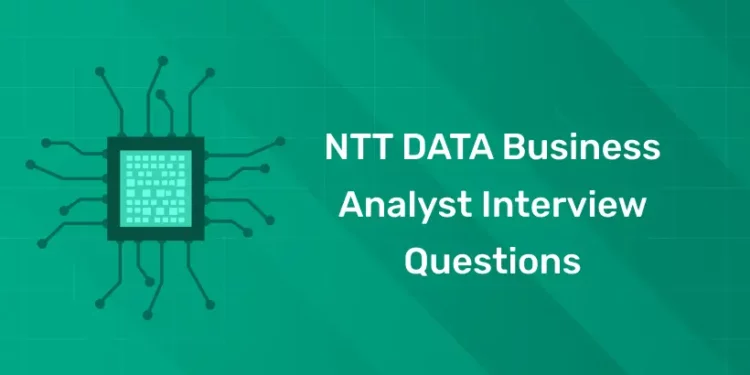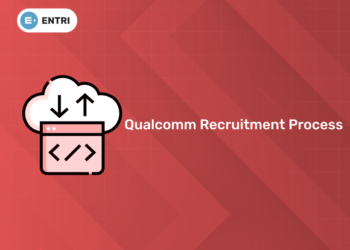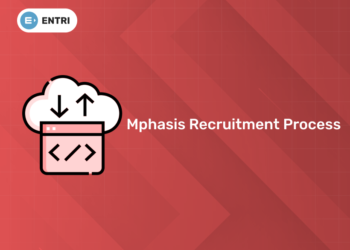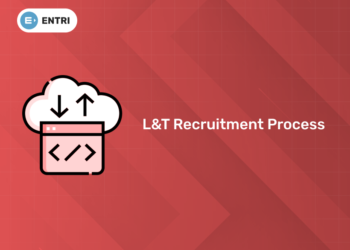Table of Contents
As businesses across the world continue to undergo digital transformation, the role of a Business Analyst has become critical in shaping the future of organizations. NTT DATA, a leading global IT service provider, is known for its commitment to delivering innovative solutions to clients. As a result, securing a Business Analyst position at NTT DATA is highly competitive.
In this blog, we will explore the most commonly asked Business Analyst interview questions at NTT DATA, covering key aspects such as problem-solving, analytical thinking, communication skills, and understanding of business processes. This guide will help you navigate through the most relevant and challenging interview questions that will test your capabilities as a Business Analyst.
Ready to take your data science skills to the next level? Sign up for a free demo today!
Introduction
NTT DATA is a global IT service provider known for its expertise in consulting, technology, and business solutions. As a Business Analyst at NTT DATA, you play a key role in bridging the gap between business objectives and technological solutions. Your primary responsibility is to understand business needs, gather and analyze requirements, and translate them into actionable insights that drive the development of effective solutions.
Business Analysts at NTT DATA are involved in various stages of the project lifecycle, from initial concept and planning to implementation and optimization. They work closely with stakeholders, including clients, project managers, and technical teams, ensuring that projects align with business goals and deliver value. The role requires strong analytical thinking, problem-solving skills, and the ability to communicate complex ideas clearly.
Working at NTT DATA offers opportunities to collaborate on innovative projects across multiple industries, and it’s a great place to grow professionally, as you will be part of a dynamic and forward-thinking team.
Why Join in NTT?
1. Global Presence and Opportunities
- NTT DATA is a global IT services leader, offering employees the chance to work on diverse projects across various industries. As a Business Analyst, you’ll have opportunities to engage in international projects, gaining exposure to different markets and challenges.
2. Professional Growth and Development
- NTT DATA is committed to nurturing talent and providing continuous learning opportunities. As a Business Analyst, you can expect to grow through training programs, certifications, and hands-on experiences, helping you expand your skills in business analysis, project management, and technology.
3. Collaborative Work Environment
- At NTT DATA, teamwork and collaboration are at the core of the company’s success. As a Business Analyst, you will work closely with cross-functional teams, including developers, project managers, and clients, enabling you to develop a well-rounded skill set.
4. Innovative Projects
- NTT DATA works on cutting-edge technology solutions, and as a Business Analyst, you will have the opportunity to be part of innovative projects that leverage advanced technologies like AI, data analytics, and automation. This exposure to the latest trends will enhance your expertise and keep you at the forefront of the industry.
5. Focus on Impact and Value Creation
- NTT DATA’s business model is centered around creating value for its clients. As a Business Analyst, you will play a crucial role in understanding client needs and helping them achieve their business objectives, which adds a sense of purpose and fulfillment to your work.
6. Strong Organizational Culture
NTT DATA fosters a positive work culture that values diversity, inclusion, and work-life balance. The company provides a supportive environment where employees feel empowered to succeed and grow both personally and professionally.
NTT Interview Preparation Tips for Business Analyst
Preparing for a Business Analyst interview at NTT DATA requires a strategic approach, as the company looks for candidates who demonstrate strong analytical thinking, effective communication, and a deep understanding of business processes. Here are some essential tips to help you succeed:
1. Understand NTT DATA’s Business and Culture
- Research NTT DATA’s services, solutions, and key industries they serve. Understand their core values, global presence, and innovative projects.
- Familiarize yourself with their company culture, including their focus on collaboration, diversity, and employee development. This will help you tailor your responses and demonstrate your alignment with their values.
2. Know the Business Analyst Role Inside and Out
- Be clear about the responsibilities of a Business Analyst at NTT DATA. Understand the end-to-end business analysis process, including gathering requirements, conducting stakeholder interviews, mapping business processes, and defining solutions.
- Be ready to discuss how you have applied these concepts in previous roles or projects. Prepare specific examples of how you’ve solved business problems, implemented solutions, and worked with cross-functional teams.
3. Master Common Business Analyst Interview Questions
- Prepare for questions about your experience in requirements gathering, stakeholder management, data analysis, and problem-solving.
- Some common questions may include:
- How do you prioritize requirements when working on a project?
- Can you describe a challenging business problem you solved and the approach you took?
- How do you handle conflicts between stakeholders with different priorities?
- Explain how you ensure that project deliverables align with business goals.
4. Demonstrate Analytical and Problem-Solving Skills
- Expect case study or situational questions where you’ll need to analyze a business problem and provide a structured solution. Practice thinking critically about business scenarios and articulating your thought process clearly.
- Showcase your ability to analyze data and make data-driven decisions. Demonstrate how you use analysis to uncover insights and influence business decisions.
5. Know the Tools and Techniques Used in Business Analysis
- Familiarize yourself with common Business Analyst tools and methodologies, such as SWOT analysis, PESTLE analysis, BPMN (Business Process Model and Notation), and use of project management tools (e.g., JIRA, Confluence, MS Excel, or others).
- Be prepared to explain your experience with these tools and how they helped you deliver business solutions.
6. Communication Skills Matter
- Strong communication is key for a Business Analyst. You’ll need to effectively communicate with both technical and non-technical stakeholders. Practice explaining complex concepts in simple terms and being concise in your responses.
- During the interview, focus on clearly articulating your ideas, demonstrating how you listen actively, and asking insightful follow-up questions to engage the interviewer.
7. Prepare for Behavioral Interviews
- NTT DATA may use behavioral interview techniques to assess how you’ve handled situations in the past. Be ready to discuss examples from your previous work experience that highlight your teamwork, leadership, conflict resolution, and decision-making abilities.
- Use the STAR method (Situation, Task, Action, Result) to structure your answers and provide detailed insights into your problem-solving approach.
Ready to take your data science skills to the next level? Sign up for a free demo today!
Top NTT Data Business Analyst Interview Questions and Answers
1. What is a Data Warehouse, and how does it differ from a Database?
Answer: A Data Warehouse is a centralized repository for storing large amounts of structured and historical data. It is optimized for reporting and analysis. Unlike a regular database, which is used for transactional processing, a Data Warehouse stores data in a way that is optimized for querying and reporting.
2. Explain the concept of ETL.
Answer: ETL stands for Extract, Transform, and Load. It is a process used to collect data from various sources, transform it into a consistent format, and then load it into a data warehouse or database for analysis and reporting.
3. What is the difference between OLAP and OLTP systems?
Answer: OLTP (Online Transaction Processing) systems are optimized for handling real-time transactional data and support daily business operations, such as order processing. OLAP (Online Analytical Processing) systems are optimized for complex queries and analysis, often used in decision-making and business intelligence.
4. Can you explain the purpose of data normalization?
Answer: Data normalization is the process of organizing data in a database to reduce redundancy and dependency. It involves breaking data into smaller, more manageable tables and establishing relationships between them. This improves data integrity and reduces the potential for errors.
5. What is a Star Schema in Data Modeling?
Answer: A Star Schema is a type of database schema used in data warehouses, consisting of a central fact table (containing quantitative data) linked to dimension tables (containing descriptive data). It is designed for easy querying and efficient reporting.
6. What are some data transformation techniques?
Answer: Data transformation techniques include aggregation, filtering, sorting, joining, and data type conversion. These techniques are used during the ETL process to convert raw data into a format suitable for analysis.
7. How do you handle missing or incomplete data in your analysis?
Answer: I handle missing data by identifying the reason for the missing information and using techniques like imputation (replacing missing values with estimated ones), removing records with missing data, or using statistical methods to account for missing values in the analysis.
8. What is a Data Dictionary, and why is it important?
Answer: A Data Dictionary is a centralized repository that defines the structure, relationships, and meaning of the data in a database. It is important because it helps ensure consistency, standardization, and understanding of the data, making it easier to use and manage.
9. Can you explain data profiling?
Answer: Data profiling is the process of analyzing data from various sources to assess its quality, completeness, consistency, and accuracy. It helps identify potential issues, such as missing values, duplicates, or incorrect data types, before the data is used for analysis.
10. What is a primary key and a foreign key in relational databases?
Answer: A primary key is a unique identifier for a record in a table. It ensures that each record is distinct. A foreign key is a field in one table that links to the primary key of another table, creating a relationship between the two tables.
11. What is the difference between Structured and Unstructured Data?
Answer: Structured data is organized in a defined format, such as tables or spreadsheets (e.g., SQL databases). Unstructured data is raw, unorganized data that doesn’t fit into traditional database structures (e.g., emails, images, videos).
12. What is a Data Mart, and how does it differ from a Data Warehouse?
Answer: A Data Mart is a smaller, more focused version of a Data Warehouse. It typically contains data for a specific department or business function (e.g., marketing or sales), while a Data Warehouse holds enterprise-wide data for cross-functional analysis.
13. What is the role of SQL in data analysis?
Answer: SQL (Structured Query Language) is used to query, manipulate, and manage data stored in relational databases. It is essential for extracting and analyzing data, creating reports, and performing data transformations.
14. What is a JOIN in SQL, and what types of JOINs do you know?
Answer: A JOIN in SQL combines records from two or more tables based on a related column. Common types of JOINs include:
- INNER JOIN: Returns only matching records from both tables.
- LEFT JOIN: Returns all records from the left table and matched records from the right table.
- RIGHT JOIN: Returns all records from the right table and matched records from the left table.
- FULL OUTER JOIN: Returns all records when there is a match in either table.
15. What is the difference between UNION and UNION ALL in SQL?
Answer: UNION combines the results of two queries and removes duplicate rows, while UNION ALL combines the results but includes duplicates. UNION is typically slower due to the need to remove duplicates.
Ready to take your data science skills to the next level? Sign up for a free demo today!
16. What is data wrangling?
Answer: Data wrangling, also known as data munging, is the process of cleaning, restructuring, and transforming raw data into a usable format for analysis. This may involve tasks like dealing with missing values, filtering out irrelevant data, and converting data types.
17. What are some common data analysis techniques?
Answer: Common data analysis techniques include descriptive statistics (mean, median, mode), regression analysis, correlation analysis, hypothesis testing, and clustering. These techniques help to identify trends, relationships, and patterns in the data.
18. What is a Pivot Table, and how do you use it?
Answer: A Pivot Table is a data analysis tool used in spreadsheet software (e.g., Excel) to summarize, analyze, and present data in a cross-tabular format. It allows you to organize and filter large datasets based on specific dimensions (e.g., sales by region, product, etc.).
19. What is the purpose of data visualization, and which tools do you use?
Answer: Data visualization helps to present complex data in an understandable and visually appealing way, making it easier to identify trends, patterns, and outliers. Tools I use include Tableau, Power BI, and Excel.
20. Can you explain the concept of data mining?
Answer: Data mining involves discovering patterns, correlations, and useful information from large datasets using techniques such as classification, clustering, and association rule mining. It helps to gain insights that can inform decision-making.
21. What is a data pipeline?
Answer: A data pipeline is a series of processes that move data from one system to another for analysis. It involves data extraction, transformation, and loading (ETL) steps, ensuring that the data is clean, accurate, and accessible for reporting and analysis.
22. What is a time-series analysis?
Answer: Time-series analysis involves analyzing data points that are collected or recorded at specific time intervals. It is used to identify trends, patterns, and seasonal variations in data over time, such as stock prices or sales data.
23. What is the difference between a clustered and a non-clustered index in SQL?
Answer: A clustered index determines the physical order of records in a table, making it more efficient for retrieving data in sorted order. A non-clustered index creates a separate structure from the data table and is used to speed up query performance.
24. What is data integrity, and why is it important?
Answer: Data integrity refers to the accuracy, consistency, and reliability of data. It is crucial because high-quality data ensures that analysis is accurate and decisions based on the data are valid.
25. How do you handle large datasets during analysis?
Answer: I handle large datasets by optimizing queries, using indexing, partitioning tables, and leveraging tools like Hadoop or Spark for distributed computing. I also use techniques like sampling or aggregating data to reduce its size while retaining important information.
26. What is a Business Analyst’s role in a project?
Answer: A Business Analyst (BA) is responsible for identifying business needs, analyzing processes, and finding technological solutions to improve efficiency. They act as a bridge between stakeholders and the development team to ensure the solution meets the business requirements.
27. What is the importance of a Business Requirements Document (BRD)?
Answer: A BRD is critical because it formally documents business requirements, ensuring alignment between stakeholders and the development team. It serves as a reference point throughout the project lifecycle and helps prevent misunderstandings.
28. What is the difference between a Business Analyst and a System Analyst?
Answer: A Business Analyst focuses on understanding business needs and ensuring solutions align with those needs, while a System Analyst focuses on designing and analyzing the technical aspects of systems to meet those requirements.
29. How do you measure the success of a business analysis project?
Answer: Success is measured by whether the business needs were met, if the solution provided value, and if the project was completed on time and within budget. Stakeholder satisfaction is also a key indicator of success.
30. Describe a challenging situation in a past project and how you overcame it.
Answer: In one project, there was resistance to a proposed system change from some stakeholders. I facilitated a series of workshops to address concerns, demonstrated the benefits of the new system, and helped them feel more comfortable with the transition.
Ready to take your data science skills to the next level? Sign up for a free demo today!










